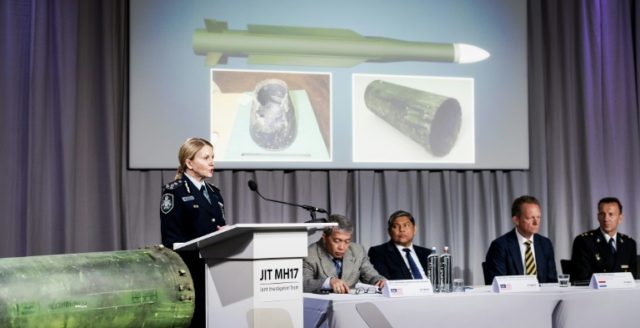The Hague (AFP) – The Netherlands and Australia on Friday moved towards launching legal action against Russia, accusing Moscow of being behind the 2014 shooting down of flight MH17 over war-torn eastern Ukraine.
It came a day after international investigators concluded that the Russian-made BUK missile which tore apart the Boeing 777 in mid-air on July 17, 2014 came from a Russian military brigade in Kursk.
The two countries “hold Russia responsible for its part in the downing” of the Malaysia Airlines flight, the Dutch government said in a statement on Friday.
They may now move towards submitting the complex dossier to an international judge or organisation, it added.
Russia however swifty denied any responsibility, with Foreign Minister Sergei Lavrov saying the Netherlands had provided “no facts” to support the findings and was merely speculating “to achieve their own political goals”.
Lavrov said he had been informed by a Dutch minister that “they have practically no doubt that the BUK (missile) came from Russia. I asked him about facts proving these claims. He did not give me any facts.”
All 298 people on board the flight en route from Amsterdam to Kuala Lumpur were killed when the missile slammed into the plane as it flew over territory held by pro-Russian rebels in eastern Ukraine.
– Russia ‘accountable’ –
Most of the dead were Dutch, but there were 17 nationalities including Australians on board.
“The downing of flight MH17 caused unimaginable suffering,” said Dutch Foreign Minister Stef Blok a day after the latest findings from the Dutch-led Joint Investigation Team (JIT).
“On the basis of the JIT’s conclusions, the Netherlands and Australia are now convinced that Russia is responsible for the deployment of the BUK installation that was used to down MH17,” he added.
“The government is now taking the next step by formally holding Russia accountable.”
The EU and NATO both urged Moscow to accept responsibility for the disaster. Russia should “fully cooperate with all efforts to establish accountability,” said the EU’s foreign policy chief Federica Mogherini in a statement.
But the Russian defence ministry has also rejected the findings, saying that although the BUK missile, part of which was presented by the JIT at a Thursday press conference, had indeed been manufactured in the Soviet Union in 1986 “all the missiles made that year were withdrawn from service in 2011”.
Those missiles made in 1986 “most likely belong to the Ukrainians,” it added.
After the collapse of the Soviet Union and “the division of military material,” Ukraine which possessed some 20 BUK anti-aircraft systems has “not had one new missile delivered,” the Russian defence ministry said.
– State liability –
The Dutch government said state liability was invoked in cases where nations violate international law, but warned it was a “complex legal process”.
“This is the legal avenue that the Netherlands and Australia have now chosen to pursue,” the statement added.
Investigators painstaking recreated the BUK missile system’s route from Kursk across the border into rebel-held eastern Ukraine using videos and photos.
The team “has come to the conclusion that the BUK-TELAR that shot down MH17 came from 53rd Anti-aircraft Missile Brigade based in Kursk in Russia,” top Dutch investigator Wilbert Paulissen said.
“The 53rd Brigade forms part of the Russian armed forces,” he told reporters Thursday.
Investigation officials, seeking to bring criminal charges, have not said who actually fired the missile. But they are appealing for further information, especially about who was among the BUK’s crew, and who ordered the plane to be shot down.
The Dutch government urged “Russia to enter into talks aimed at finding a solution that would do justice to the tremendous suffering and damage caused by the downing of MH17.”
Meanwhile, the investigative site Bellingcat claimed it had identified the second of two men whom the JIT has fingered as top suspects after obtaining their wire-tapped conversations before and after the plane was shot out of the sky.
Bellingcat has alleged that both men are top-ranking Russian military officials.
“All points lead to a centralised military operation,” Bellingcat researcher Moritz Rakuszitzky told reporters.
“Transporting and using a sophisticated anti-aircraft device such as the BUK is not something that either separatists or non-military mercenaries could ever be trusted with.”

COMMENTS
Please let us know if you're having issues with commenting.